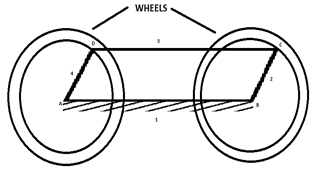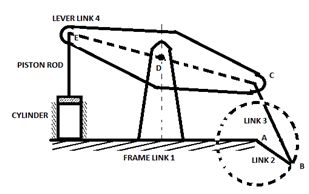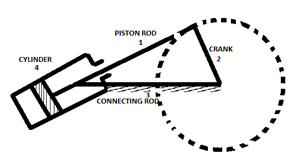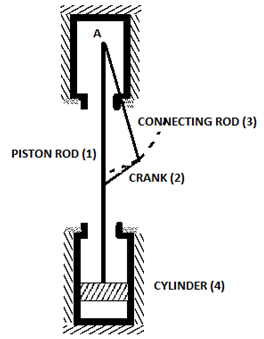This set of Theory of Machines Multiple Choice Questions & Answers (MCQs) focuses on “Kinematic Inversion”.
1. The method to obtain different types of mechanisms by fixing different links in a kinematic chain is known as inversion of mechanism. True or False.
a) True
b) False
View Answer
Explanation: Many mechanisms can be obtained as the number of links in a kinematic chain by fixing, different links in a kinematic chain one by one. Here the relative motions of the links of the mechanisms do not change. Fixing different links would result in different types of motions. This method is called as inversion of mechanism.
2. Which of these is an inversion of a single slider crank chain?
a) Coupling rod of a locomotive
b) Beam engine
c) Watt’s indicator mechanism
d) Pendulum pump
View Answer
Explanation: Beam engine, coupling rod of a locomotive, watt’s indicator mechanism are all inversions of a four bar chain whereas the pendulum pump is an inversion of a single slider crank chain.
3. In the given inversion of four bar chain, the link 1 is fixed. Which one is it?

a) Coupling rod of a locomotive
b) Beam engine
c) Bull engine
d) Rotary internal combustion engine
View Answer
Explanation: CD is a coupling rod and link AB is fixed so as to maintain a constant centre to centre distance between them. This mechanism is used to transmit rotary motion from one wheel to the other wheel. When a wheel rotates, the connecting rod starts reciprocating. The other end of the connecting rod is fixed with the second circle which also starts moving.
4. What is the use of beam engine?
a) To convert rotary motion into oscillatory motion
b) To convert rotary motion into reciprocating motion
c) To convert reciprocating motion into rotary motion
d) To convert oscillatory motion into rotary motion
View Answer
Explanation: In this, due to the rotation of the crank about the fixed centre A, the lever oscillates about the point D. Point E of the lever CDE is connected to a piston rod which reciprocates due to the rotation of the crank i.e. this mechanism converts rotary motion into reciprocating motion.
5. In the given inversion of a four bar chain rotary motion is converted into reciprocating motion. Which one is it?

a) Rotary internal combustion engine
b) Watt’s indicator mechanism
c) Beam engine
d) Bull engine
View Answer
Explanation: In this, due to the rotation of the crank about the fixed centre A, the lever oscillates about centre D. E is connected to a piston rod which reciprocates due to rotation of the crank. In other words, the purpose of this mechanism is to convert rotary motion of the crank into reciprocating motion. It is a beam engine or a crank lever mechanism.
6. What is the purpose of the oscillating cylinder engine?
a) To convert rotary motion into oscillatory motion
b) To convert reciprocating motion into rotary motion
c) To convert rotary motion into reciprocating motion
d) To convert oscillatory motion into rotary motion
View Answer
Explanation: The oscillating cylinder engine is used to convert reciprocating motion into rotary motion. The cylinder oscillates, as the piston is moved by the crank shaft. Thus, due to the reciprocating motion of the crank shaft, the cylinder oscillates resulting in rotary motion.
7. The following mechanism is an inversion of a single slider crank chain obtained by fixing link 3. What is the name of the mechanism?

a) Pendulum pump
b) Gnome engine
c) Oscillating cylinder engine
d) Watt’s indicator mechanism
View Answer
Explanation: It is used in converting reciprocating motion to rotary motion. In this, link 3 (connecting rod) is fixed. When the crank (link 2) rotates, the piston attached to piston rod reciprocates and the cylinder (link 4) oscillates about a pin pivoted to the fixed link at A. Nowadays, oscillating cylinder engine are used in small toys and models but they were previously used in ships and small stationary engines.
8. The pressure of gas or steam which acts on the indicator plunger can be measured using a ______________
a) Rotary internal combustion engine
b) Watt’s indicator mechanism
c) Bull engine
d) Oscillating cylinder engine
View Answer
Explanation: The displacement of the link is proportional to the pressure of gas or steam which acts on the piston rod. Thus, by calculating the amount of displacement, the pressure of the gas or steam can be calculated. This mechanism was used in Watt’s engines.
9. Watt’s indicator mechanism is an inversion of a single slider crank chain. True or false.
a) True
b) False
View Answer
Explanation: Watt’s indicator mechanism is not an inversion of a slider crank chain but is an inversion of a four bar chain. Thus, the given statement is false. In Watt’s mechanisms, link 1 is fixed whereas links 3 and 4 act as lever.
10. Identify the mechanism:

a) Watt’s indicator mechanism
b) Bull engine
c) Beam engine
d) Rotary internal combustion engine
View Answer
Explanation: The given diagram is of a bull engine or pendulum pump. Here, link 4 is fixed at A. In this inversion the slotted link shape is given to the slider to get the desired motion.
11. Rotary internal combustion engine is an inversion of a four bar chain. True or false?
a) True
b) False
View Answer
Explanation: Rotary internal combustion engine or a gnome engine is an inversion of single slider crank chain and not a four bar chain. Thus, the statement is false. In the rotary I.C. engine the crank (link 2) is fixed. The pistons, connecting rod and the fixed crank form the inversion of the slider crank chain.
12. The relative motions between different links changes due to the process of inversion. True or false?
a) True
b) False
View Answer
Explanation: The relative motions between the various links do not change through the process of inversion, but the motions measured with respect to the fixed link change. Thus, the given statement is false.
Sanfoundry Global Education & Learning Series – Theory of Machines.
To practice all areas of Theory of Machines, here is complete set of 1000+ Multiple Choice Questions and Answers.
If you find a mistake in question / option / answer, kindly take a screenshot and email to [email protected]
- Check Mechanical Engineering Books
- Apply for Mechanical Engineering Internship
- Check Agricultural Engineering Books
- Apply for Agricultural Engineering Internship
- Check Theory of Machine Books
